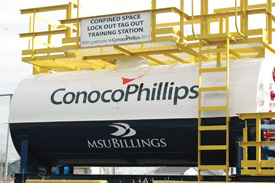University Communications and Marketing
Specialized COT training equipment to be dedicated next week
July 15, 2011
Contacts:
Bob Good, College of Technology Power Plant Technology Program, 247-3028
Dan Carter, University Relations, 657-2269
Kathie Riggs, MSU Billings Foundation, 657-1620
Donated by ConocoPhillips, lockout/tagout equipment will train MSU Billings College of Technology students on important safety procedures
MSU BILLINGS NEWS SERVICES — It looks like something that might fit better on the back of a truck, but the large tank on the eastern edge of the Montana State University Billings College of Technology campus is something that will teach students how to be safer at work — and possibly save lives.
 ConocoPhillips has donated a lockout/tagout training tank to the MSU Billings College
of Technology’s Power Plant Technology program so that students can truly understand
what it’s like to safely “lock out” potentially hazardous equipment and energy sources.
ConocoPhillips has donated a lockout/tagout training tank to the MSU Billings College
of Technology’s Power Plant Technology program so that students can truly understand
what it’s like to safely “lock out” potentially hazardous equipment and energy sources.
The training unit will be formally dedicated on Tuesday, July 19 in a small 11:30 a.m. ceremony at the MSU Billings COT campus, 3803 Central Ave.
The control of hazardous energy is a major safety concern in many workplace sectors. The federal Occupational Safety and Health Administration (OSHA) have guidelines that address the practices and procedures necessary to disable equipment and prevent the release of hazardous energy while employees perform servicing and maintenance activities. Those hazardous energies could come from electrical, mechanical, hydraulic, pneumatic, chemical, thermal and other energy sources.
According to OSHA, compliance with the lockout/tagout standard prevents an estimated 120 fatalities and 50,000 injuries each year. Workers injured on the job from exposure to hazardous energy lose an average of 24 workdays for recuperation.
MSU Billings COT students who are a part of the Process Plant Technology and Power Plant Technology programs deal with lock out/tagout procedures as part of their curriculum. It’s an important part of understanding the workplace, said Bob Good, power plant technology instructor. But now instead of just doing reading on the issue, students can actually experience it.
Good said he will use the 10-foot diameter tank this fall for the 38 students who take his safety classes.
“They need to know how to deal with confined space entry,” he said. “They will strap on the harness and feel just how restrictive it is to move in a confined space environment.”
Working with a partner, the students enter a pitch-black environment with a harness and communicate their work. Once the simulated situation is addressed, it can be “locked and tagged” to identify isolation.
Good, a former employee of PPL Montana, said the training unit will be invaluable for students as they enter the job market because they can tell potential employers they’ve addressed this important aspect of their work.
The donated training tank, estimated at $20,000, is the latest contribution by ConocoPhillips to the MSU Billings COT.
The company has been a longtime proponent of higher education and an ardent supporter of the university for more than 20 years. In recent years, the company has contributed both in-kind and financial support to the Process Plant Technology program. The COT and ConocoPhillips began working on the lockout/tagout confined space entry project three years ago and came to fruition this spring.
Good said the hands-on training station will be useful to other COT programs and related training such as fire science and hazardous materials training.
For more information on programs at the MSU Billings College of Technology, go to www.msubillings.edu/citycollege or call 247-3000. To find out more about the ceremony recognizing the donation, call Kathie Riggs at the MSU Billings Foundation at 657-1620.
PHOTO ABOVE: This lockout/tagout unit will help train MSU Billings College of Technology students on important safety procedures. It was donated by ConocoPhillips as part of its ongoing relationship with MSU Billings to support higher education and workforce training.
